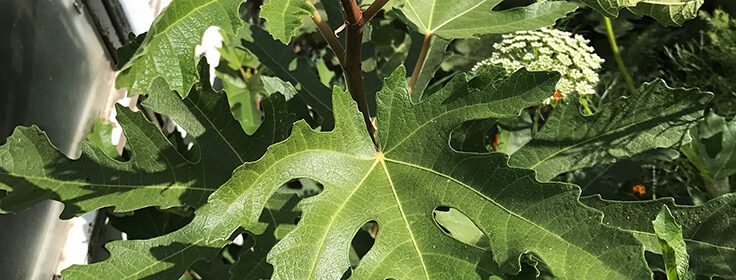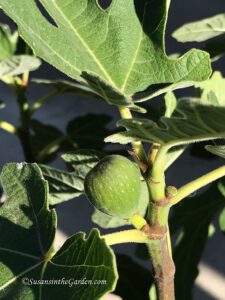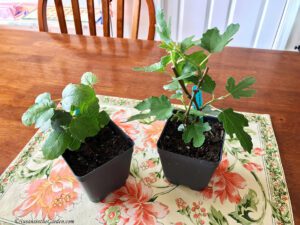June 14 Column: Growing Figs

For this week’s garden column, I wrote about our adventures in growing figs. Yes, figs in our zone 5b garden! You can read it in today’s edition of The Spokesman-Review: With figs, it’s best to contain your excitement. (or you can read my column at the bottom of this post)
Mind you, it’s not like we’ve had a whole lot of success. But we’re feeling hopeful that we will actually get some figs this year. That fig in the photo to the left is the one and only little fig that our ‘Chicago Hardy’ fig put out last year. Sadly, it was super late in the season and we had a killing frost well before it would have been ripe enough to pick. Darn! But hey, it’s the thought that counts.
If you’re wondering where we bought ours, they came from Burpee. After doing a quick web search, I found this source for a huge variety of figs for many different hardiness zones. I have never ordered anything from Rolling River Nursery, but you might have fun looking at their selections. Whew knew there were so many fig cultivars? While there are a lot of other online sources for figs, I always recommend that you check with your local independent garden centers first.
One thing I wanted to clarify about our figs is their growth habit. When most of us think of figs, we think TREES. Well, our little figs have a shrubby growth habit and we’re totally OK with that (photo to the right shows what we started with). So if you’re puzzling over the shape of our fig plants, that’s my explanation! Since our plan is to move them into our garden each winter, I think shrubs will be more easy to handle than trees.
Are you thinking about growing figs? They sure are pretty plants and, when all goes well, there are sweet rewards for your efforts!
In this week’s “Everyone Can Grow a Garden” video, I show you our two figs, explain a bit about their set-up, and then take you along while I complete a couple of springtime tasks. I hope you’ll enjoy it:
Growing Figs garden column:
I’ve been noticing a common trait among gardeners: we all love to push the envelope a bit. We regularly engage in what is known as zonal denial by purchasing plants that aren’t suited for our hardiness zone because we are certain those plants will happily grow in our own gardens if given plenty of tender loving care.
We also tend to be envious of gardeners in warmer zones who can grow fabulous plants such as artichokes and figs year-round. In my case, it just didn’t seem fair that folks on the West side could grow figs while it wasn’t even an option for Inland Northwest gardeners. At least, I thought it wasn’t.
In 2016, I spotted some hardy figs for sale in a plant catalog. The two cultivars, Chicago Hardy and Violette de Bordeaux, were listed as being hardy down to USDA zone 5. My husband, Bill, and I jumped at the chance to give them a try.
When the tiny plants arrived that spring, we carefully planted them on the south side of our small greenhouse. That seemed like a nice, sunny spot. They only grew a little that first summer, having more of a shrubby growth habit rather being actual fig trees. As winter approached, we started feeling apprehensive. Would they make it through a Spokane winter?
The next spring, we discovered the plants had died back to the roots but soon there were new sprouts coming up. We babied the plants through the growing season. In preparation for their second winter, we decided to mulch them heavily to provide some insulation.
Once again, the plants survived but died back to the roots. We were starting to feel pretty discouraged. After all, if a plant is to fruit on branches, you need those branches to be alive in the spring.
In 2018, Bill and I visited some wonderful botanical gardens in England. At two of them, we noticed they were growing figs – and rather well, I might add. Wisley Gardens had a sign near their fig plantings that said, “They do best when the roots are restricted, in a container or in a ‘planting pit’ against a wall.” We saw a similar sign at the other garden.
That’s when the lightbulb came on: let’s grow them in large containers and move them into our garage during the winter. Last spring, we dug up the figs. We filled their pots with organic potting soil, watered them regularly, and occasionally fed them with a balanced fertilizer. They spent the summer on a sunny patio. Violette de Bordeaux produced one tiny fig which didn’t ripen in time but it was a start.
Last fall, we waited until we had a hard frost and the figs dropped their leaves. After giving them a good watering, we moved them into the garage. During the winter, I checked on them monthly and watered them lightly so they wouldn’t dry out.
After moving them back outside this spring, I could see a bit of new growth at base of the plants but the branches appeared to be dead. I almost removed them but am so glad I didn’t. It turns out the branches are very slow to sprout new leaves in the spring. Soon, I was seeing those supposedly dead branches leafing out.
Maybe, just maybe, we’ll get some fruit this year. I will keep you posted.
Hardy figs:
The following fig cultivars will grow in zones 5 and 6:
- Chicago Hardy
- Letizia
- Olympian
- Violette de Bordeaux
- White Marseilles


